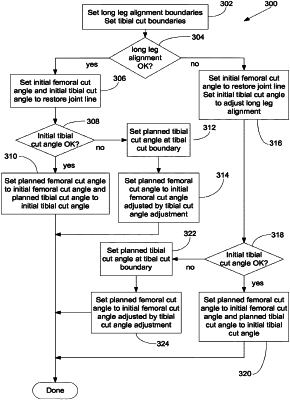| CPC A61B 34/10 (2016.02) [A61B 17/155 (2013.01); A61B 17/157 (2013.01); A61B 2017/564 (2013.01); A61B 2034/104 (2016.02); A61B 2034/105 (2016.02); A61B 2034/108 (2016.02); A61B 2034/2046 (2016.02); A61F 2/38 (2013.01); A61F 2002/4633 (2013.01)] | 1 Claim |

|
1. A method of carrying out a total knee replacement surgical procedure on a knee of a leg of a patient, comprising:
obtaining anatomical data for the leg of the patient, wherein the anatomical data allows the femoral mechanical axis, the tibial mechanical axis and the joint line of the knee to be determined;
determining a final planned proximal tibial cut angle and a final planned distal femoral cut angle, wherein the final planned proximal tibial cut angle and the final planned distal femoral cut angle ensures that a long leg angle between the tibial mechanical axis and the femoral mechanical axis resulting from the final planned proximal tibial cut angle and the final planned distal femoral cut angle corresponds to an angle within a first pre-selected range of values and the final planned proximal tibial cut angle corresponds to an angle within a second pre-selected range of values; and
carrying out a total knee replacement procedure on the knee of the patient, wherein a distal femoral cut is made using the final planned distal femoral cut angle along a final planned femoral cut line and a proximal tibial cut is made using the final planned proximal tibial cut angle along a final planned tibial cut line,
wherein determining the final planned proximal tibial cut angle and the final planned distal femoral cut angle includes:
determining the joint line is within tibial cut boundaries,
setting an initially planned proximal tibial cut angle to result in an initially planned tibial cut line to restore the joint line and an initially planned distal femoral cut angle to result in an initially planned femoral cut line to restore the joint line, wherein the initially planned tibial cut line is parallel to the initially planned femoral cut line,
determining an initial long leg angle between the tibial mechanical axis and the femoral mechanical axis based on the initially planned proximal tibial cut angle and the initially planned distal femoral cut angle,
determining whether the initial long leg angle corresponds to an angle within the first pre-selected range of values, and
setting the final planned distal femoral cut angle based on whether the initial long leg angle corresponds to an angle within the first pre-selected range of values,
wherein when the initial long leg angle does not correspond to an angle within the first pre-selected range of values:
adjusting the initially planned distal femoral cut angle to a final planned distal femoral cut angle, wherein (i) at the final planned distal femoral cut angle, the initial long leg angle is adjusted to a final long leg angle corresponding to an angle within the first pre-selected range of values, and (ii) the final planned distal femoral cut angle results in the final planned femoral cut line, and
setting the initially planned proximal tibial cut angle to the final planned proximal tibial cut angle and the initially planned tibial cut line to the final planned tibial cut line, wherein the final planned tibial cut line is not parallel to the final planned distal femoral cut angle.
|